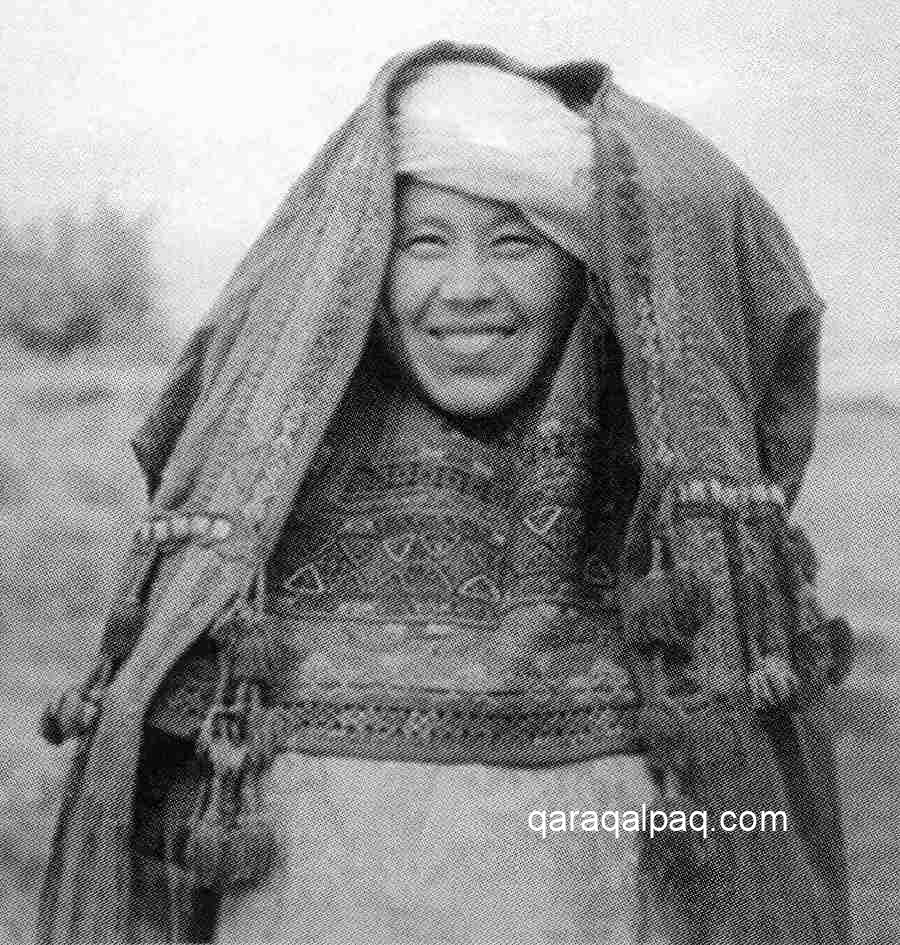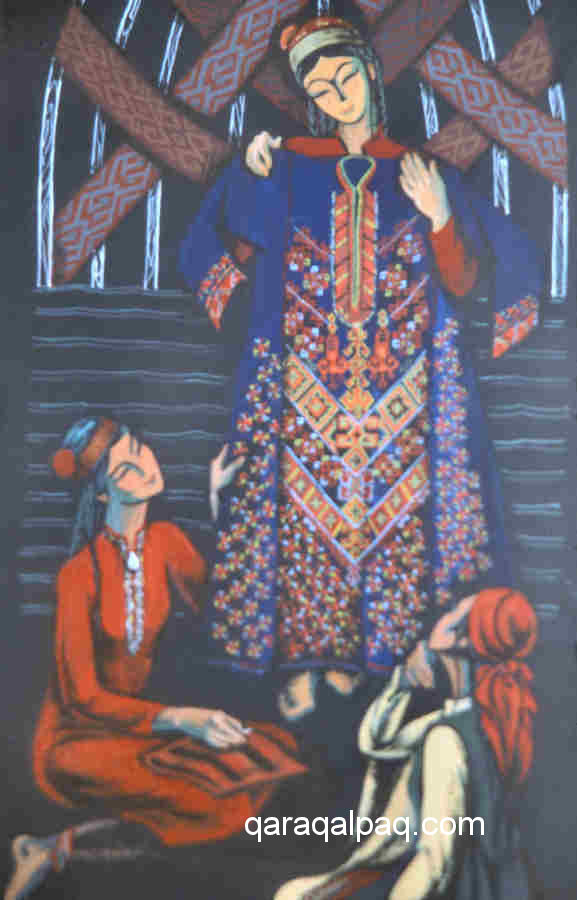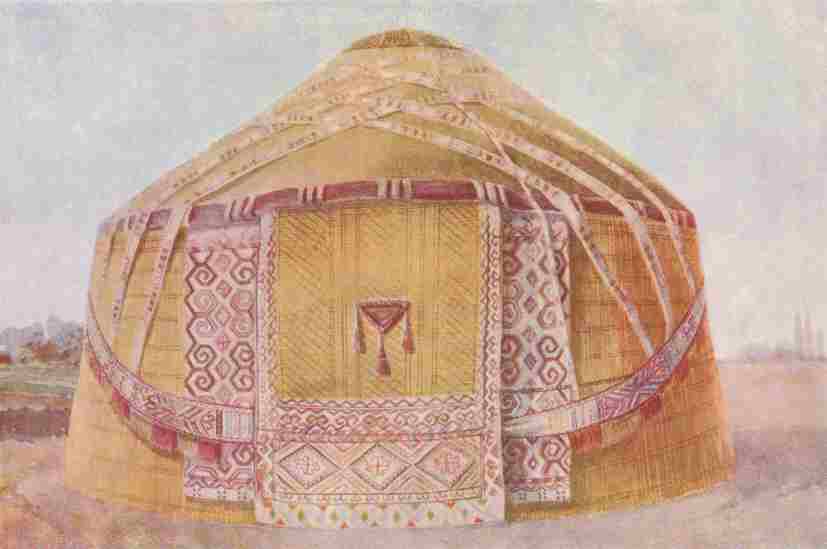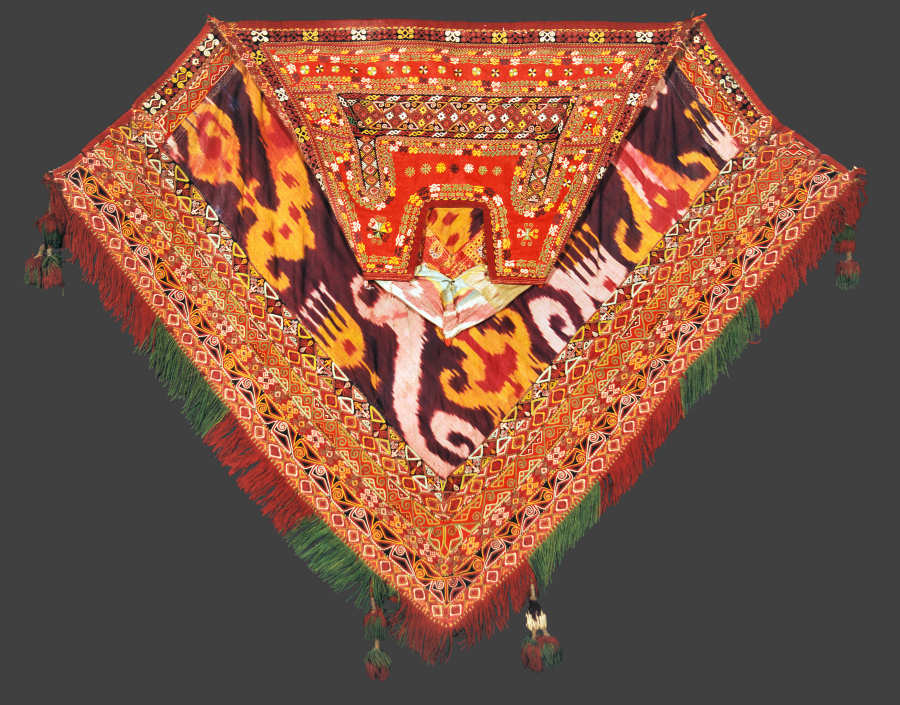|
Forthcoming Lectures
Lecture: 'Pierced Fingers: The Art of Qaraqalpaq Embroidery'
Painting of a Qaraqalpaq bridal hair veil, known as a qizil kiymeshek (red kiymeshek).
Painted by Olga Joldasova in 1952.
Qaraqalpaq folk art is not only vibrant, raw, and powerful but is also extremely varied. Qaraqalpaq embroideries, costumes, and yurt decorations
incorporate amazing contrasts of colour and texture - sometimes understated and reserved, sometimes dramatic and assertive.
Fashion is, and always has been, dynamic - not only for us in the West but also for many traditional ethnic societies. David and Sue will show how the
textiles and decorative embroidery techniques used by the Qaraqalpaqs changed dramatically over time, leading to a revolution in women's ceremonial
costume. They will show that the factors that brought about these changes were many and varied, ranging from conquest and forced migration, to
cross-cultural exchange and the expanding international trade in textiles.
Time and date: 2.00pm, Saturday 3 October 2015.
Location: All Hallows Church Hall, 1 Greenhill Road, Mossley Hill, Liverpool, Merseyside LI8 6JJ.
Please note that non-members are welcome for a small charge.
Previous Lectures
Lecture: 'Evolution of the Qaraqalpaq Kiymeshek: A Central Asian Example of Ever-Changing Fashion'
A married Qaraqalpaq woman dressed in her ceremonial kiymeshek, topped by a turban and a jegde,
the latter always worn out-of-doors.
The Qaraqalpaq red qızıl kiymeshek is one of the most stunning ethnic garments to have come out of Central Asia. It was a ceremonial
headdress designed to completely conceal the hair of a bride or young married woman, protecting her and her unborn child from the harmful threat of
the 'evil eye'. The white aq kiymeshek seems to have been adopted by the Qaraqalpaqs at some time in the mid-nineteenth century. However such
kiymesheks were simpler garments made from home-woven cotton bo'z embroidered in cross-stitch. By the late nineteenth century the
influx of new textiles from the factories of Russia and the workshops of Khiva had led to a dramatic transformation in Qaraqalpaq women's ceremonial
costumes and the emergence of the larger and more stunning red qızıl kiymeshek embroidered in chain-stitch.
Sue Richardson's lecture focuses on the emergence, evolution, and demise of the kiymeshek from the eighteenth century to the present day,
just one example of the ever-changing face of Qaraqalpaq female costume.
Time and date: 11.30am, Tuesday 12 February 2013.
Location: Room B104, First Floor, The Brunei Gallery, Thornhaugh Street, Russell Square, London, WC1H 0XG.
Lecture: 'Qaraqalpaq Textile and Embroidery Fashions'
A young prospective Qaraqalpaq bride with her cross-stitch embroidered ko'k ko'ylek (blue dress).
Painted by Olga Joldasova in 1952.
Qaraqalpaq folk art is not only vibrant, raw, and powerful but is also extremely varied. Qaraqalpaq embroideries, costumes, and yurt decorations
incorporate amazing contrasts of colour and texture - sometimes understated and reserved, sometimes dramatic and assertive.
Fashion is and always has been dynamic - not only for us in the West but also for many traditional ethnic societies. David and Sue will show how the
textiles and decorative embroidery techniques used by the Qaraqalpaqs changed dramatically over time, leading to a revolution in women's ceremonial
costume. They will show that the factors that brought about these changes were many and varied, ranging from conquest and forced migration, to
cross-cultural exchange and the expanding international trade in textiles.
Time and date: 2.00pm, Saturday 6 July 2013.
Location: The Union Chapel, Wellington Road (off Wilbraham Rd), Fallowfield, Manchester, M14 6EQ.
Please note that access is restricted to Embroiderers' Guild members.
Lecture: 'Qara U'y - The Qaraqalpaq Yurt and its Decoration'
A wealthy Qaraqalpaq family's yurt at Moynaq, painted by Boris Andrianov, a young archaeologist and
ethnographer attached to the Khorezm Archaeological and Ethnographic Expedition, in 1946.
A fully decorated Qaraqalpaq yurt is a joyful sight - one of the most delightful nomadic dwellings in the whole of Central Asia.
However Qaraqalpaq weavings have never been properly researched and remain relatively unknown compared to those of their Qazaq,
Uzbek, or Turkmen neighbours. Many items that are labelled Qaraqalpaq are not Qaraqalpaq at all, while genuine Qaraqalpaq weavings
are frequently mislabelled and incorrectly dated.
After introducing the Qaraqalpaqs and describing their unusual formerly semi-nomadic lifestyle, David and Sue will describe the
special features of the Qaraqalpaq qara u'y and how it was made. The key focus of their talk will be the various structural
and decorative weavings associated with the yurt, along with Qaraqalpaq storage bags, rugs, and carpets. They will explain how they
were woven and how they were used. They will end by attempting to resolve the long-standing controversy that has surrounded Qaraqalpaq
carpets for over a century.
2012 Lecture Programme:
Time and date: 5.45pm, 25 August 2012. Refreshments available from 5.15pm.
Location: Pauling Centre for Human Sciences, 58 Banbury Road, Oxford, OX2 6QS.
OATG members free. Non-members welcome for a modest £2.00 admission fee.
Time and date: 6.15pm, Friday, September 7, 2012. Refreshments available from 5.30pm.
Location: Minasian Oriental Rug Company, 1244 Chicago Avenue, Evanston, IL.
Rug and Textile Society of Indiana, Indianapolis, IN.
Time and date: 3.00pm, Sunday, September 9, 2012.
Location: Adult Lecture Room A, Indianapolis Museum of Art, 4000 Michigan Road, Indianapolis, IN 46208.
Please note that because of limited room size the society can only accommodate 10 non-members on a first-come first-served basis.
Time and date: 6.30pm, Tuesday, September 11, 2012. Non members welcome, $10 guest fee.
Location: Pioneer Hall, 1642 43rd Avenue East, Seattle, WA 98112.
Time and date: 7.30pm, Thursday, September 13, 2012. Guests free, non members welcome.
Location: Emmett Eilands Oriental Rug Gallery, 1326 Ninth Street, Berkeley, CA.
Time and date: 10.00am to 12.30am, Saturday, September 15, 2012. Guests free, non members welcome.
Location: UCLA Campus, Room 314, Royce Hall, 340 Royce Drive, Los Angeles, CA 90095.
Venue kindly provided by the
UCLA Asia Institute.
Time and date: 3.00pm, Sunday, September 23, 2012. Guests free, non members welcome.
Location: Arlington County Library Auditorium, Second Floor Meeting Room, 1015 North Quincy Street, Arlington, VA 22201.
Directions to Arlington County Library from Key Bridge:
Head south on Francis Scott Key Bridge into Virginia
Turn right on Lee Highway (just past the Marriott Hotel). Go 2 miles along Lee Highway.
Turn left onto N Quincy St (by Honda dealer). Go 1 mile.
The Arlington Central Library is at left, at 1015 N Quincy Street.
There is free parking both above and below ground on the left, just as you approach the library. There is also a larger free parking lot above ground next to the library if you turn left at 10th Street N.
Time and date: 6.45pm, Monday, September 24, 2012. Doors open at 6.00pm.
Location: The Coffee House Club, 20 West 44th Street, 6th Floor, New York, NY 10036.
Please note that this lecture is not open to the general public.
Time and date: 7.30pm, Friday, September 28, 2012.
Location: First Parish, 14 Bedford Road, Lincoln, MA 01773.
Lecture: The Influence of Tribal Conflict, the 'Great Game', and Trade on Qaraqalpaq Costume
A magnificent qızıl kiymeshek with a quyrıq made from Khivan
sarı adras.
Collection of the former Qaraqalpaq Regional Studies Museum, No'kis, inventory number 4182.
Formed as a small confederation of Turkic tribes on the middle Syr Darya in the mid-sixteenth century, the Qaraqalpaqs continually sought
defensive alliances with the more powerful sedentary states and nomadic hordes that surrounded them, even attempting to gain the protection
of Imperial Russia by swearing allegiance to the Empress in 1743. As the Qazaqs of the Junior Horde steadily forced them south into their
present homeland in the Aral Delta they increasingly came under the domination of the Khivan Uzbeks. The material culture of the Qaraqalpaqs
was not only changed by the cultural influence of the Khivans but came close to annihilation as a result of increasingly repressive taxation.
It was rescued thanks to the Russians, who began their military advance into Turkestan in the mid-nineteenth century which culminated with
the conquest of the remote Khanate of Khiva in 1873. The majority of Qaraqalpaqs finally became citizens of Russian Turkestan.
Russia's newly emerging textile industry was quick to exploit its newly-opened colonial markets. As the prosperity of the Qaraqalpaqs began
to improve they not only gained exposure to Khivan semi-silk ikat, pure silk sashes, polished alacha and the culture of farmed
cotton, but also had access to Russian woollen broadcloth, inexpensive printed chintz and woollen shawls. Over time they began to incorporate
these new textiles into their costume. At first the changes were modest but by the start of the twentieth century the new textiles had inspired
stunningly new decorative embroidery designs and dramatic new fashions.
The Textile Society of America, Biennial Symposium:
'Textiles & Politics', Washington, DC.
Time and Date: Approximately 11.30am, Friday, September 21, 2012.
Location: Hermitage Room, Washington Court Hotel, 525 New Jersey Avenue, Washington, DC 20001.
Attendance restricted to TSA symposium delegates.
Lecture: Kiymesheks and Qarshıns: Insights into Two Qaraqalpaq Textiles
Time and date: 7.00pm, Wednesday 22 September 2010.
Location: Swedenborg Hall, 20/21 Bloomsbury Way, London, WC1A 2TH.
Entrance round the corner on Barter Street, two minutes from the British Museum.
Lecture: Karakalpak Costume: Ever Changing Fashions in Western Central Asia
Time and date: 5.45pm, 25 August 2012. Refreshments available from 5.15pm.
Location: Pauling Centre for Human Sciences, 58 Banbury Road, Oxford, OX2 6QS.
OATG members free. Non-members welcome for a modest £2.00 admission fee.
Forthcoming Articles
HALI, Number 175, London.
'Book Review - Qaraqalpaqs of the Aral Delta, written by Andy Hale'
Spring Edition 2013.
'The Qaraqalpaqs and the Aral Sea Crisis'
Spring Edition 2013, published March 2013. Downloadable online.
'The Qaraqalpaq Yurt and its Decoration'
Summer 2013 Edition.
Recent Articles
HALI, Number 173, London.
'Outwitting the Evil Eye'
September/October Edition 2012.
'The Symbolism of Livestock Horns among the Qaraqalpaqs'
Summer 2012 Edition.
'The Qaraqalpaq Qızıl Kiymeshek'
June 2012 Edition
Hand/Eye Magazine, Issue 03, Spring/Summer 2010.
'Protect & Defend'
'The Kiymeshek of the Karakalpaks'
'A comprehensive introduction to the Karakalpaks', Sheila Paine.
'Unravelling the mysteries of the Karakalpaks. David and Sue Richardson examine two of their favourite textiles.'
HALI, Number 142, September/October 2005.
'The Karakalpaks - The Forgotten Tribe of Central Asia'
Return to top of page
Home Page
|
|
![]()
![]()




